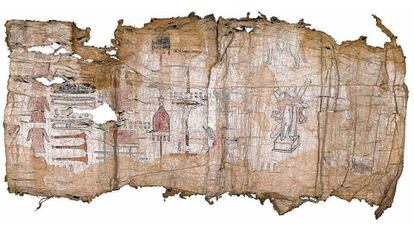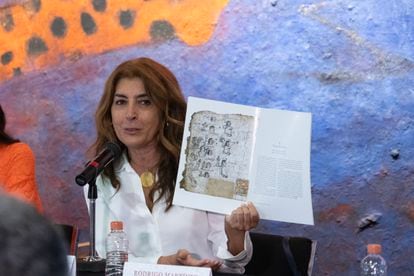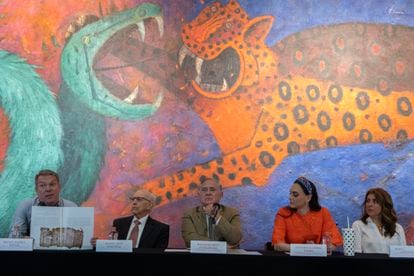María Castañeda de la Paz is still moved when she remembers when she first encountered the so-called Codices of San Andrés Tetepilco. It was 2009 and the historian was on vacation when a colleague told her that he had a friend who kept some documents that might be of interest to her. The academic went to the meeting in the vain neighborhood of Coyoacán, south of the Mexican capital, and was breathless when she found copies of the codices, one of them very relevant because it tells the history of Tenochtitlan, the ancient capital of the empire. “It is not every day that documents like this appear,” says Castañeda de la Paz. “I was super happy and surprised, because a document about the history of Tenochtitlan is very rare,” she says. The researcher is part of a team of experts who this Wednesday presented the discovery at the Museum of Anthropology in Mexico City, after years of research and negotiations, which ended with the payment of 9.5 million pesos (half a million dollars). ) to the family that owned these historical pieces.


The work to recover documents dating from the late 16th century and early 17th century was long and fraught with setbacks. “The person who showed photographs of the codices on a computer told me that they belonged to a family that he did not give me the information about, but she assured me that they had two or three documents. They gave me color copies and I began to do some studies and I said that they should be registered, because if not, the price could go up a lot on the black market, but those who had the codices did not want to know anything. I didn't know if that family really was the owner and over time, much to my regret, all interest faded. I tried to contact them several times, but they put me off,” says Castañeda de la Paz, who is a researcher at the UNAM Anthropological Research Institute.

Given the inability to convince those who were guarding the valuable works, she contacted Baltazar Brito Guadarrama, owner of the National Library of Anthropology and History (BNAH), and showed him the copies. It was Brito who was in charge of searching for the family and finding the codices. “My surprise was huge when I opened the little box they were in. When I lifted the first sheet I immediately knew it was an original document,” says Brito. The authorities of the National Institute of Anthropology and History (INAH) have not given details of the people who possessed them, but Brito has assured that they alleged that they had the documents “from very ancient times” and that they were passed down through generations within the same lineage. .
Brito has explained that according to the Monuments Law, historical assets such as a painting from the viceroyalty can be in private hands or be inherited, but they cannot leave Mexico. The INAH authorities have been able to verify the authenticity of the codices. These are three viceregal pictographic documents that contain information related to the past of the Mexican capital. The first of them narrates the founding of the town of San Andrés Tetepilco, located in Iztapalapa, south of Mexico City; The second is an inventory of the church of San Andrés Tetepilco, made up of two sheets of amate paper glued together that record a list of the temple's assets. And the third codex is the one that Castañeda de la Paz calls “the jewel in the crown”, the most important “for its formal dimension, invoice and information, which narrates the history of Tenochtitlan through four main themes: the founding of the city in the 14th century; the registration of the tlatoque or lords who ruled it in pre-Hispanic times; the arrival of the Spanish conquistadors in 1519, and, finally, the viceregal period, until 1611,” the INAH explains.

The historian Rafael Tena has explained that after the arrival of the Spanish, the indigenous people continued making some codices, but with the influence of contact with European culture, with which they learned to incorporate techniques such as the third dimension, shading and perspective, in addition to alphabetical glosses, “either in the original languages as well as in Spanish,” he notes. Tena assures that the codices stopped being produced at the end of the 16th century and many of the existing ones “took the path of the world” and ended up in private hands in Europe and the United States. “Here we preserve half of all the codices that were made, and that is why it is a wonder that after several centuries very interesting, very beautiful new materials continue to appear that enrich our national heritage and the knowledge of our history,” he explains.
The texts presented this Tuesday will be subjected to further research and conservation processes and will be kept in the BNAH codices vault, which has a collection of enormous value. “The chronology of what we normally know about history is being adjusted and that surprises us,” says historian Castañeda de la Paz, still surprised that these valuable strips exist and are now available to experts to understand more about the complex. puzzle of Mexican history.
Subscribe to the EL PAÍS Mexico newsletter and to whatsapp channel and receive all the key information on current events in this country.
Subscribe to continue reading
Read without limits
_
#Mexico #recovers #codices #narrate #rise #fall #Tenochtitlan
/cloudfront-eu-central-1.images.arcpublishing.com/prisa/7MYPHMINTBGXFMSWSZX6DU2DNU.jpg)
Leave a Reply